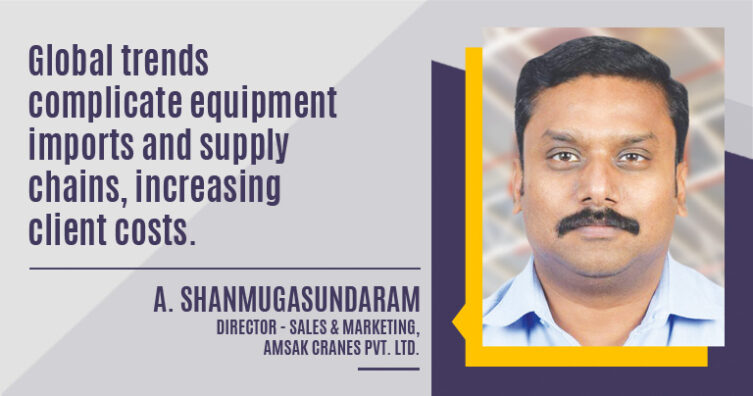A. Shanmugasundaram of Amsak Cranes elaborates on the life expectancy of cranes, which depends on maintenance and usage while discussing the demand patterns for cranes and hoists. Frequent maintenance, operator training, improvements, and monitoring can all help to extend their useful life.
What are India’s current demand trends for single- and double-girder cranes and hoists?
The growth of the Indian crane and hoist market can be attributed to the increasing demand in various end-use industries, such as factories, plants, transportation, warehouses, and others. The increasing construction activities bring forth the crane and hoist market growth, as cranes are commonly used in the construction industry for various tasks, including lifting and moving heavy materials and equipment, loading and unloading vehicles, and assembling products or components. Single- and double-girder cranes and hoists have witnessed significant use in various industries, such as construction, mining, excavation, and logistics.
What innovations are required for heavy-duty and extra-heavy-duty cranes for steel, cement, and warehouse storage?
Innovations are required for heavy-duty and extra-heavy-duty cranes to improve productivity, safety, and efficiency in steel, cement, and warehouse storage industries. Here are some potential areas for innovation: automation and robotics, advanced sensors and IoT, monitoring systems, electric and hybrid power, and enhanced materials and designs. Generally, innovation in heavy-duty and extra-heavy-duty cranes is vital for improving safety, productivity, and efficiency in the steel, cement, and warehouse storage industries.

How are global trends complicating equipment imports and supply chains and increasing client costs?
Global trends are having a high impact on equipment imports and supply chains, leading to increased client costs. Trade disputes and tariffs between countries can increase costs for clients relying on equipment imports. Supply chain disruptions, such as the COVID-19 pandemic, cause delays and shortages in equipment imports, making it more demanding. Increasing demand for equipment in certain industries can lead to shortages and higher prices. Variations and changes in regulations can impact the import and export of equipment, leading to increased costs for clients. Currency fluctuations can affect the cost of imported equipment, as changes in exchange rates can make equipment more expensive for clients who purchase it in their local currency.
What is the minimum life expectancy of these cranes? What measures have you taken to ensure minimum maintenance requirements for your fleet of cranes?
The type of crane, usage, and maintenance schedule influences the minimum life expectancy of cranes. Heavy-duty and extra-heavy-duty cranes can have a minimum life expectancy of 20-30 years with proper maintenance. To minimise maintenance requirements for a fleet of cranes, regular periodic maintenance, operator training, upgrades, modernisation, monitoring, and inspections, as well as collaboration with suppliers, can be undertaken. Routine maintenance involves inspections, lubrication, and cleaning to keep the cranes functioning optimally. Operator training helps to ensure that the cranes are being used correctly, which can reduce the likelihood of accidents and damage to the cranes. Upgrades and modernisation can improve the cranes’ performance and efficiency, making them more reliable and cost-effective. Monitoring and inspections can identify potential issues before they become major problems, allowing for proactive maintenance and reducing the risk of breakdowns. Collaboration with suppliers can help ensure that replacement parts and components are readily available.
What safety and quality standards does your organisation adhere to achieve the highest precision and reliability? Organisations follow several safety and quality norms to ensure maximum precision and reliability. These may include adherence to ISO standards, quality management, environmental management, and occupational health and safety. Compliance with OSHA standards is also essential for workplace safety, particularly concerning industrial equipment and machinery. Finally, the CE marking certification indicates that a product complies with European Union safety standards.
For more details visit: https://amsakcranes.com/
Cookie Consent
We use cookies to personalize your experience. By continuing to visit this website you agree to our Terms & Conditions, Privacy Policy and Cookie Policy.
















